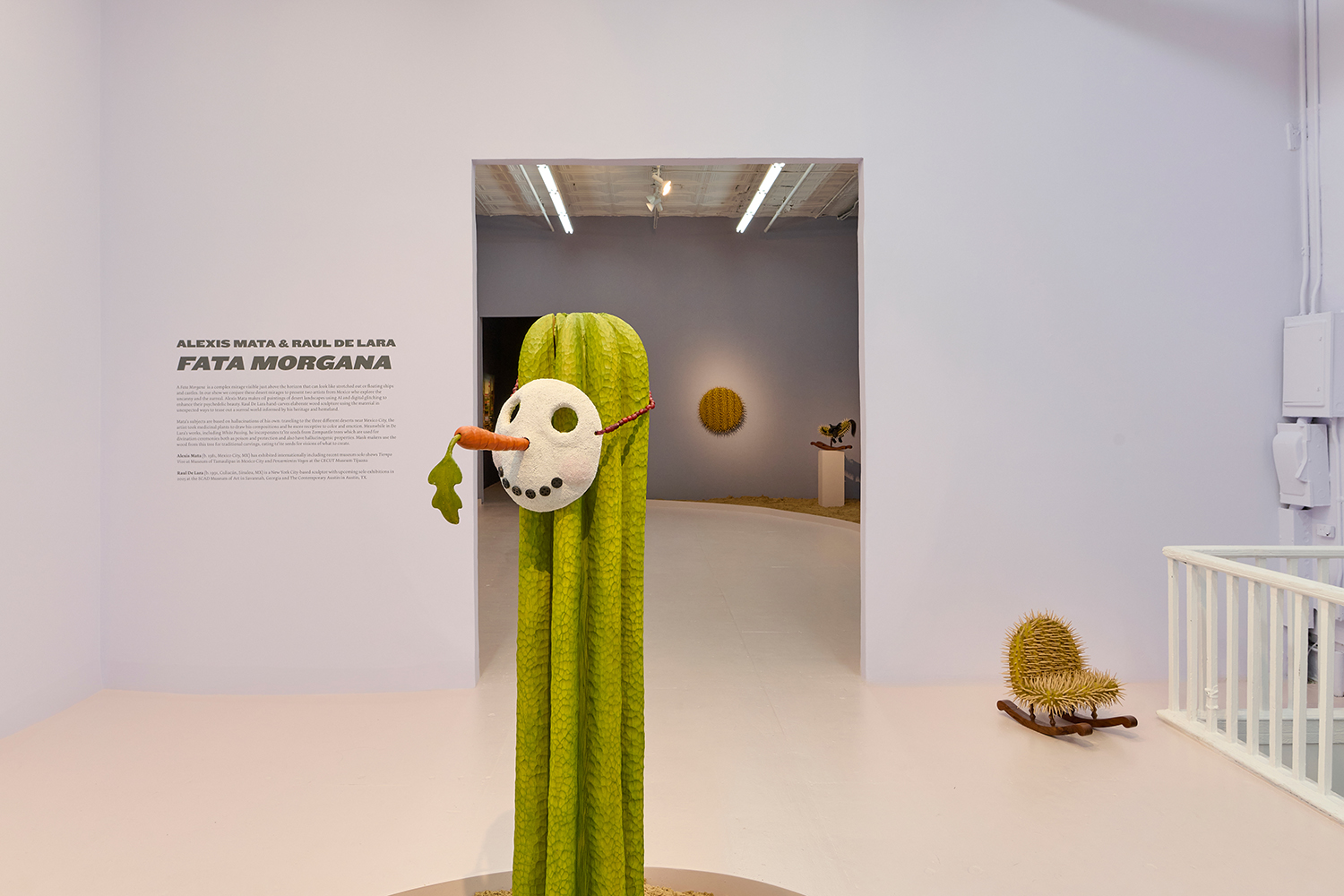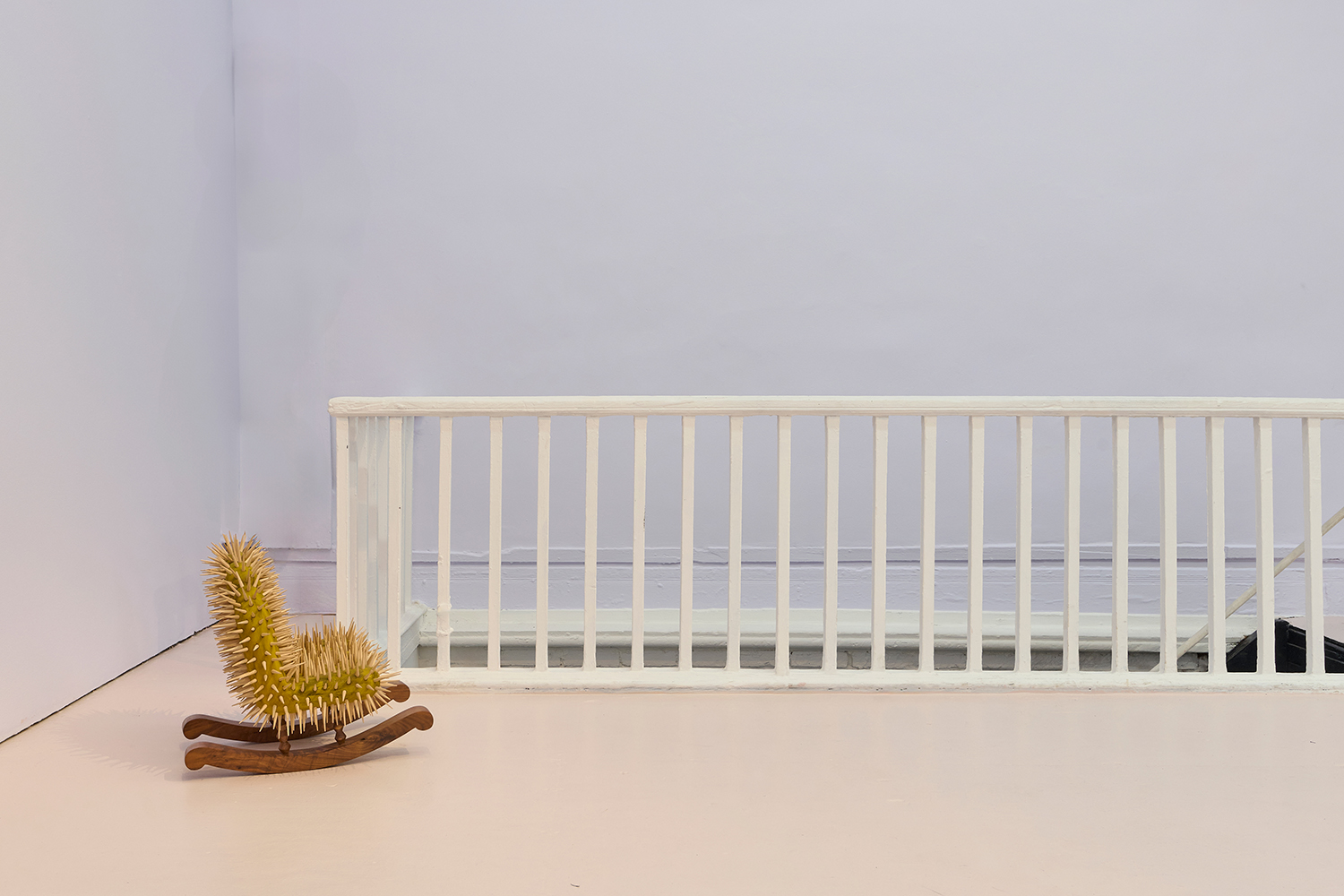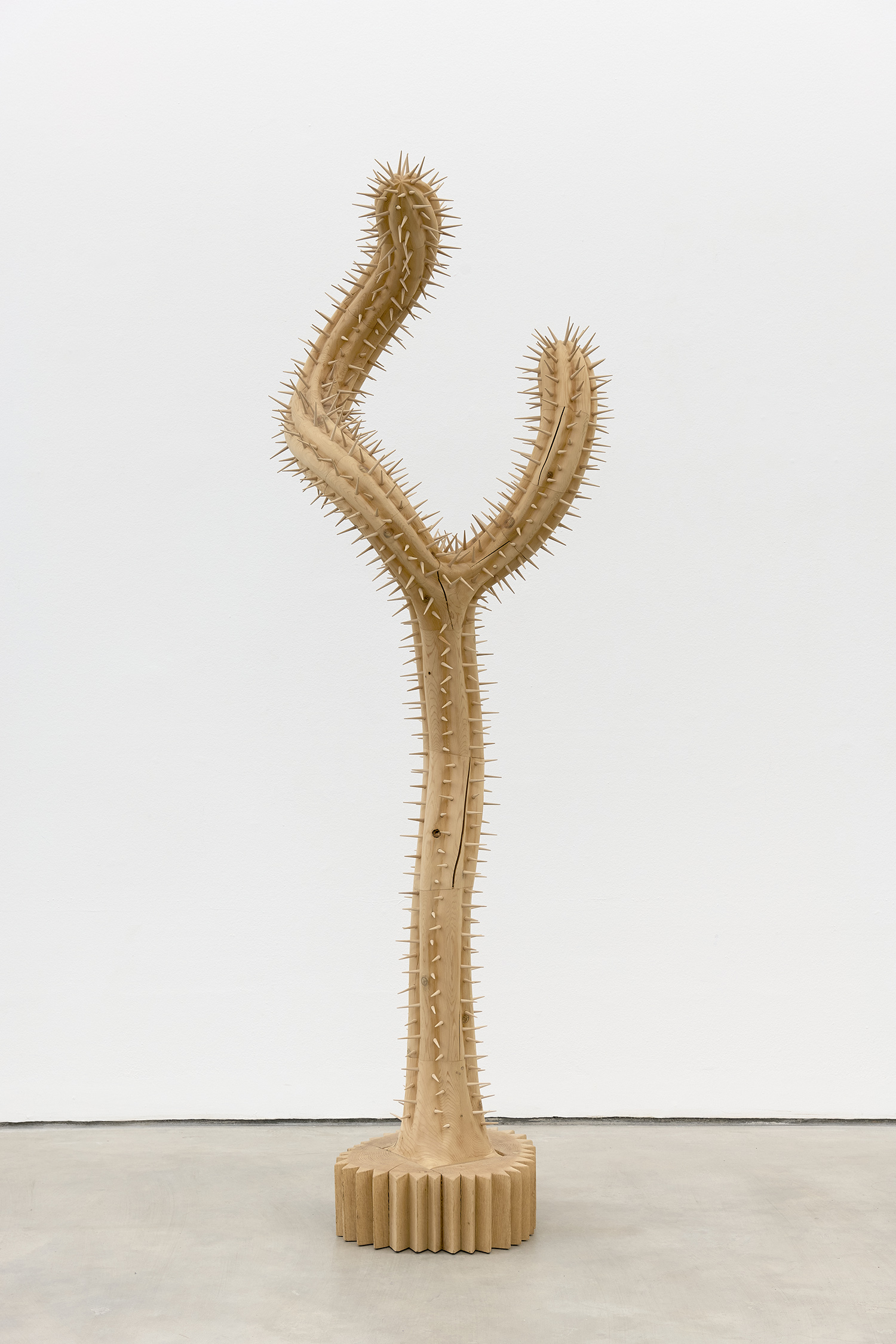The Hole is proud to announce a special two-person exhibition combining paintings by Alexis Mata and sculpture by Raul De Lara: Fata Morgana.
For this exhibition we juxtapose seven new oil paintings by Mexico City-based artist Alexis Mata with seven sculptures by New York-based Mexican artist Raul De Lara. The works are hung on increasingly dark walls as the sun sets and the sculptures are nestled in sand pits: as the show provokes your imagination, a mirage of the desert might appear.
A “Fata Morgana” is a complex mirage visible just above the horizon. Named after Morgan le Fay a sorceress from the legend of King Arthur, Fata Morgana mirages tend to look like stretched out or floating castles, ships or mountains. Mata’s subjects are based on hallucinations of his own: traveling to the three different deserts near Mexico City, the artist took medicinal plants to draw his compositions and be more receptive to color and interiority. Meanwhile in De Lara’s White Passing he incorporates tz’ite seeds from Zompantle trees which are used for divination ceremonies, poison and protection and also have hallucinogenic properties. Mask-makers use the wood from this tree for traditional carvings, eating tz’ite seeds for visions of what to create.
“The paintings are all about the glitch and the error, when your eyes look too long at the same thing your mind makes the change” AM
While the exhibition plays tricks with your eyes, De Lara’s technical prowess is palpable, utilizing a myriad of highly labor intensive traditional wood carving techniques to cut, carve and sand each detail manually. The artist’s hand and knowledge are evident, unlike the output of CNC we tend to see; in Saguaro #2 eleven hundred tantalizing hand-carved spikes make a splinter appealing. De Lara was in a woodshop by the age of 10 and has worked with woodworkers and taught in shops throughout his career. Only recently he has begun using tools to digitally draw his sculptures in space, sketches that allow him to visualise the work in advance before gravity gets involved.
Mata’s multidisciplinary practice, however, has explored digital interventions for years: here we see glitching frames generated with AI, like moments of memory loss and the implementation of error to distort through an analogue-digital process. The reinvention of the real as fiction by erasing the limits between the virtual and the palpable, the original and the replica. From personal still life images, this series revolves around the poetics of disappearance. Featuring the transmutation of flowers facing the promise of change, the pieces no longer only expose flaws and errors, but also become deformed to the point of abstraction, disappearing amidst their infinite forms. With some works like Volar para observar no longer reading as landscapes but patterns.
Scale is key in both artists’ new body of work. For Alexis these are the largest canvases he has painted to date, the landscapes sprawling and the horizons unclear, and the wide horizontal paintings wrapping around us in a panorama. De Lara’s scale from towering to tiny functions with familiarity, reflecting how scale becomes lost or at least vague with memory. In the childlike size of the rocking horses Torito and Leticia or the rocking chair The Wait (Again) we feel scales shift with age, how your childhood bed felt huge at one time.
Subtly running through the exhibition is the artists’ pride for their homeland. From the prominence of nopales (cactus found in Mexican flag) and CDMX-specific fruits and flowers in Mata’s painting to the highly personal narratives carved into each of De Lara’s sculpture, both artists are imbuing their art with their Mexican heritage. De Lara immigrated from Mexico to the United States at the age of 12 and is a DACA recipient, currently still unable to freely travel outside the United States, and his work reflects on ideas around nationality, queer identity and the immigrant experience. Together we see patriotism through the respect of landscape and life, representations of the diversity of landscape we are losing, conserving places and preserving home through their practice with a show that feels very much alive.
“The works in this show are still breathing”
“Wood expands and contracts all it’s life, if installation shots were at a microscopic level maybe we could see it”. RDL
Alexis Mata (b. 1981, Mexico City, MX) is a multidisciplinary artist whose work explores the intersection of digital and analog mediums. His work has been exhibited widely in museums internationally including solo shows “Tiempo Vivo” at Museum of Tamaulipas in Mexico City and “Pensamientos Vagos” at the CECUT Museum Tijuana, as well as group shows “Mexico: Pintura Recreativa” at Carrilo Gill’s Art Museum in Mexico City, “Persistencia de la Memoria” at MUCA Rome Museum, Mexico City, “La raíz de mi falla” Exhibition Hall of Fine Arts, Puebla. Mata has previously exhibited with name his other commercial art galleries here.
Raul De Lara (b. 1991, Culiacán, Sinaloa, MX) is a New York City-based sculptor who immigrated from Mexico to the United States at the age of 12. He earned his BFA in Studio Art from The University of Texas at Austin in 2015 and went on to earn an MFA in Sculpture and Extended Media from Virginia Commonwealth University in 2019. His work has been exhibited widely across the US including solo exhibitions at Reynolds Gallery in Richmond, Virginia; Ethan Cohen Gallery in New York City and Beacon, New York; Fine Arts Work Center in Provincetown, Massachusetts; Prizer Gallery in Austin, Texas; and has an upcoming solo exhibitions in 2025 at the SCAD Museum of Art in Savannah, Georgia and and The Contemporary Austin in Austin, TX . He has been included in group exhibitions including The Hole, the Wharton Esherick Museum in Paoli, Pennsylvania, MINT Gallery in Munich, Half Gallery and Honor Fraser Gallery. He has collaborated with brands such as Hermes and his work has been reviewed in Art in America and ARTnews.
For all sales inquiries email sales@thehole.com.




















Raul De Lara, White Passing, 2020, Pine, zompantle, linden, sand, acrylic, red string, texas laurel seeds, epoxy, oak, 64 x 10 x 16 inches, 163 x 25 x 41 cm.

Raul De Lara, Saguaro #2, 2021, Cedar, oak, hemu, steel, 88 x 29 x 20 inches, 224 x 74 x 51 cm

Raul De Lara, Like Two Leaves in a Pot, 2024, Walnut, red oak, polyx-wax, 38 x 18 x 27 inches, 96.5 x 46 x 68.6 cm

Raul De Lara, Leticia, 2021, Cedar, walnut, cowhide, steel, horse hair, acrylic, lacquer, red string, 20 x 10 x 28 inches, 51 x 25 x 71 cm.

Raul De Lara, Torito, 2021, Cedar, walnut, wenge, pine, leather, horse hair, lacquer, acrylic, 17 x 24 x 10 inches, 43 x 61 x 25.4 cm.

Raul De Lara, The Wait (Again), 2022, Walnut, cedar, hemu, lacquer, color pencil, urethane, pigment, 20.5 x 19 x 21 inches, 52 x 48 x 53 cm.

Raul De Lara, Cactus Study (#1), 2023, Pine, hemu, walnut, pigment, urethane, 29 x 29 x 5 inches, 73 x 73 x 12 cm.

Alexis Mata, Luna Llena, 2024, Oil on canvas, 91 x 71 inches, 230 x 180 cm.

Alexis Mata, Atardecer En El Desierto, 2024, Oil on canvas, 91 x 71 inches, 230 x 180 cm.

Alexis Mata, Luna Nueva, 2024, Oil on canvas, 91 x 71 inches, 230 x 180 cm.

Alexis Mata, La Tarde De Cactus, 2024, Oil on canvas, 59 x 91 inches, 150 x 230 cm.

Alexis Mata, CACTUS AURORABOREAL, 2024, Oil on canvas, 53 x 91 inches, 135 x 230 cm.

Alexis Mata, Volar Para Observar, 2024, Oil on canvas, 79 x 79 inches, 200 x 200 cm.

Alexis Mata, El Espejo En El Desierto, 2024, Oil on canvas, 73 x 59 inches, 185 x 150 cm.

Alexis Mata, Paisaje Cactus, 2024, Oil on canvas, 47 x 73 inches, 120 x 185 cm.

Alexis Mata, El Día En El Valle De Los Cactus, 2024, Oil on canvas, 47 x 73 inches, 120 x 185 cm.